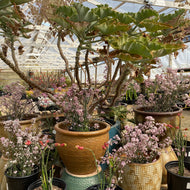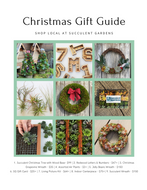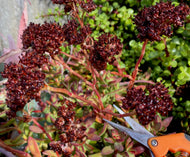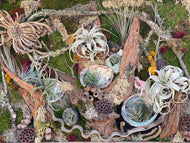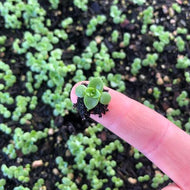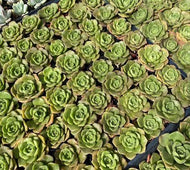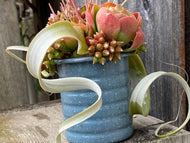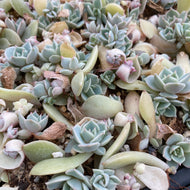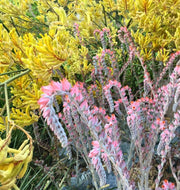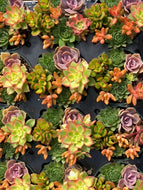 While incorporating succulents into bouquets might be trendy now, this tradition has a long history. I was recently invited to participate in a jointly sponsored program of the Garden Conservancy and the Ruth Bancroft Garden. Debra Prinzing, co-author of the book The 50 Mile Bouquet: Seasonal, Local, Sustainable Flowers, invited me to participate alongside her to add what I could about using succulents in bouquets.
While incorporating succulents into bouquets might be trendy now, this tradition has a long history. I was recently invited to participate in a jointly sponsored program of the Garden Conservancy and the Ruth Bancroft Garden. Debra Prinzing, co-author of the book The 50 Mile Bouquet: Seasonal, Local, Sustainable Flowers, invited me to participate alongside her to add what I could about using succulents in bouquets.
Debra's invitation to join her in her talk was inspirational for me in many ways. The 50 Mile Bouquet focuses on the concept of buying local, emphasizes sustainability, and includes interviews and information from regional experts around the country. The creativity and vision of the individuals profiled in Debra's book are inspiring. Reading the book and co-presenting with Debra also took me back to 1981, 31 years ago, when my oldest son and his preschool buddy Sara were photographed for an article in Sunset Magazine about succulents in bouquets.

In this picture from the 1981 article, my son Zach, who is now 37, is on the right looking at a bouquet featuring E. gibbiflora hybrid flowers. In the center is Sara Shoemaker Lind, who is now a professional photographer. She has photographed many of my plants for use in my new succulent encyclopedia. (Her sister Aimee is on the left, looking up.)
Around the same time that the article appeared in Sunset, I was working with the University of California Davis, sending cuttings of succulents for their vase life tests to test the longevity of fresh plant material for use in cut flower arrangements.
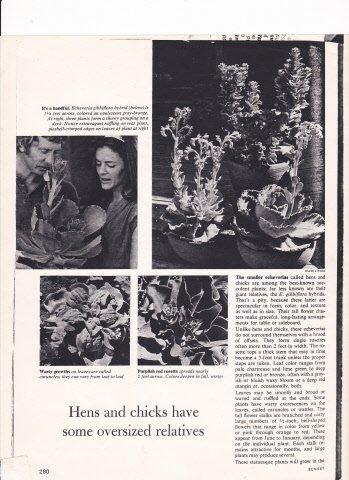
Above, the 1981 article in Sunset Magazine featuring Robin Stockwell talking about different uses for Echeveria gibbiflora hybrids, including using Echeveria and Aeonium rosettes and flowers in bouquets.
Using Locally Sourced Materials in Bouquets
 Debra's talk at Heather Farms included photos of sustainable materials used in bouquets and an informative discussion of the current state of the floral industry. It was, essentially, an interactive, in-person demonstration of the book, which highlights the many advantages of shopping for locally grown floral materials, giving many examples of uniquely local materials that can be combined into beautiful bouquets. Debra's co-author, David Perry, shot the exquisite photographs that demonstrate the beauty of these unique and sustainably grown bouquets.
Debra's talk at Heather Farms included photos of sustainable materials used in bouquets and an informative discussion of the current state of the floral industry. It was, essentially, an interactive, in-person demonstration of the book, which highlights the many advantages of shopping for locally grown floral materials, giving many examples of uniquely local materials that can be combined into beautiful bouquets. Debra's co-author, David Perry, shot the exquisite photographs that demonstrate the beauty of these unique and sustainably grown bouquets.
At this point, I am sounding like a book review, which was not my intent, but I was just so inspired and excited by Debra and David's book and honored and grateful to present with Debra. It was an incredibly synergistic experience.
Integrating Succulents into Bouquets
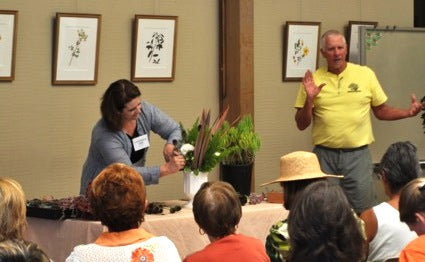
As Debra wrapped up her talk, I came forward to speak about growing succulents and using them in bouquets. Debra began creating a couple of bouquets using more traditional flowers and materials. While Debra was preparing materials in two separate vases, I began my demonstration on how to remove cuttings from Aeoniums and Senecios. I handed the cuttings to Debra and she began introducing the succulent cuttings into the bouquets she was assembling.
The audience gasped when I lopped off a 10" Echeveria gibbiflora hybrid with a thick 1" stem to use in the bouquet!
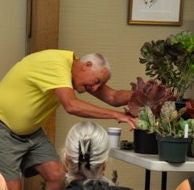
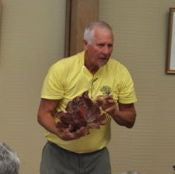
Don't worry! The Echeveria gibbiflora hybrid pictured above will grow roots and can be re-planted. The stem will also produce offsets that can be planted.
Try This at Home
Because most of you couldn't be at my talk, I wanted to share the highlights with you here. You can try this with plants cut from your own garden! Here are some quick tips for using succulents in bouquets.
- You can use flower and/or foliage cuttings from succulents in bouquets. Foliage of succulents such as Echeveria and Aeonium are rosette forms that look much like a flower. You can also use the actual flowers from Aeonium and hybrid Echeveria. The hybrid Echeverias produce flowers on stems ranging from 12" to 36" tall from June through September.

Succulents pictured in the above bouquet are hybrid Echeveria flowers (trailing pink flowers) and Aeonium rosettes.
- When cutting rosettes from various succulent varieties, use a clean cutting tool that cuts and does not crush the stem.
- Cuttings can be placed in water with other flowers and foliage and will generally hold up just fine. Succulent cuttings usually last much longer than other materials. The succulent flowers will eventually dry up and can be composted.

Aeonium nobile lends flair in the bouquet pictured above.
The Beauty of Long-Lasting Succulent Cuttings
Long after most of the other materials in your bouquets have dried up and added to the compost pile most of the succulent cuttings in your bouquet will have produced roots and can be planted in a container or in the garden.
You won't just get new plants from the rooted cuttings, though. The plants from which you took the cuttings will also usually produce new offsets or branches.
Just think--if you include succulents in your wedding bouquet, you can, potentially, keep part of your bouquet alive forever! The same cannot be said of regular cut flowers.
Succulent Flowers and Foliage for Bouquets
Look around your garden to find succulent foliage and flowers for your hand-tied bouquets or vased flower arrangements. Once you start looking at your plants with an eye toward design, you'll find delightful choices everywhere.


Pictured above: Aeonium nobile flowers (left) and Aloe ferox flowers (right)
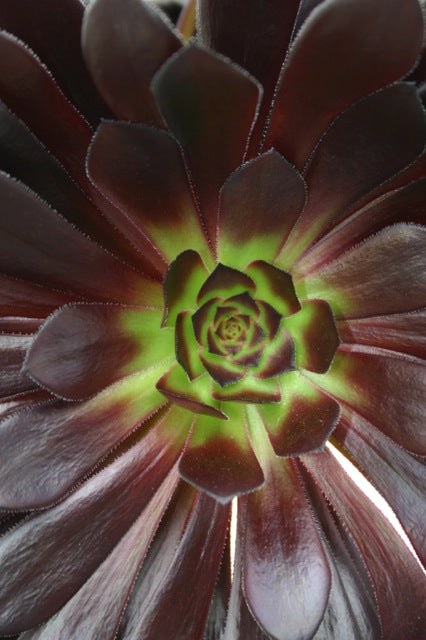

Pictured above: Aeonium 'Zwartkop' foliage (left) and Aeonium 'Sunburst' foliage (right)
Succulent Floral Design to be Featured at the Succulent Extravaganza
If this article has whet your appetite for more, make plants to attend Succulent Extravaganza. Baylor Chapman of Lila B design will be speaking at the Succulent Extravaganza on Friday, September 28 (time to be determined). She will be sharing her vision and techniques of floral design working with succulentsand traditional flowers and foliage. I plan to turn Baylor loose to choose the succulents to use in some of the work she will be demonstrating. Visit the Lila B Design website here.
Stay tuned for the full lineup of Succulent Extravaganza speakers. Save the dates on your calendar: Friday, September 27 and Saturday, September 28. We'll see you there!

